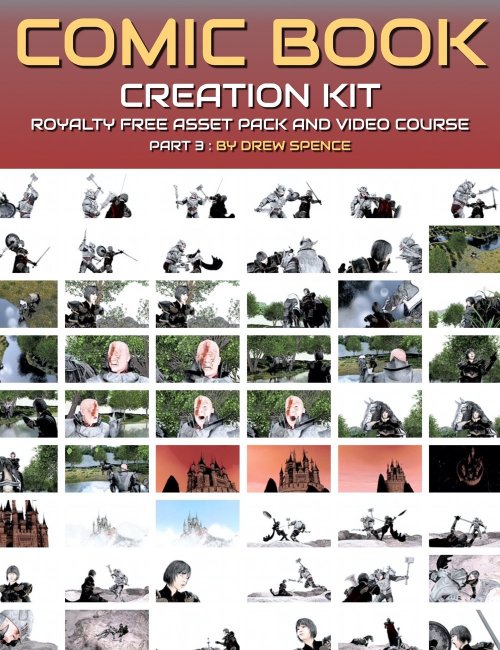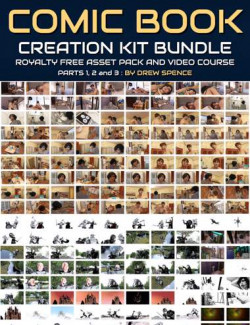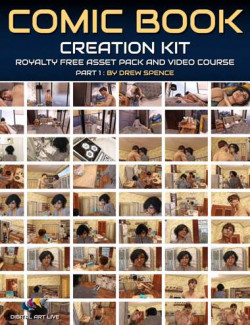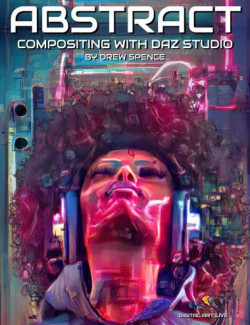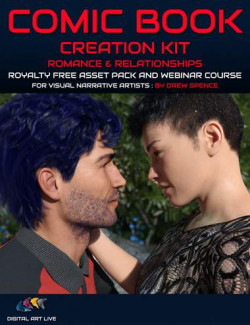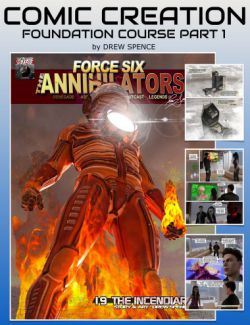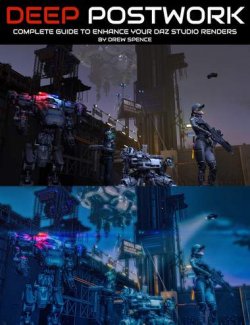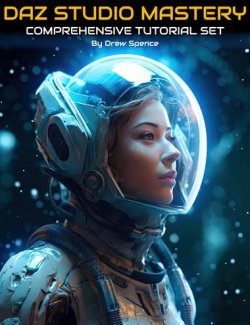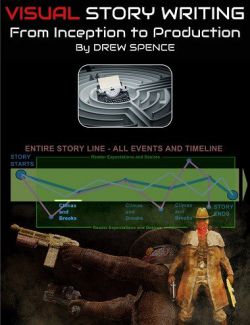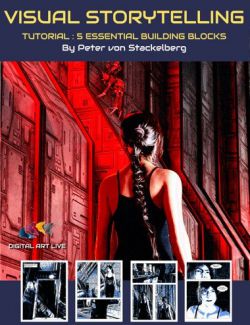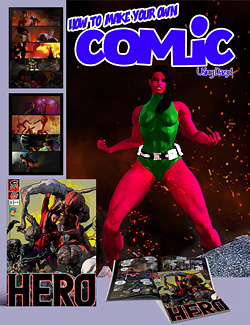A comic book is a powerful medium of expression that speaks to a wide variety of ideas and emotions across all genres. DAZ Studio is a great tool to generate renders for your creating comic book artwork!
However, it can take a great deal of time in building and rendering those scenes. The Comic Book Creation kit saves you time and energy in providing you with over a hundred renders ready to select from and build your own comic book. This kit includes an extensive video course of over 5 hours of instruction and insights on composing your comic by Drew Spence, a professional comic book artist. This part includes insights from comic book legends such as John Byrne.
The artwork in this kit is royalty-free - so you are free to create and publish your own stories with this kit.
The asset packs in this product contain over 750 PNG images for building your story panels.
- Sci-fi rendered characters, props, and backgrounds
- Renders in portrait, hand-drawn, line, and sketch styles
Drew teaches you how to use and arrange the elements of a comic book:
- Panels
- Lettering
- Word/Thought balloons
- Captions
- Sound effects
- Panels
- Borders
- Gutters
He shows you how to...
- Map a story structure onto a comic book layout
- Show, rather than tell a dynamic story
- Progress and express characters through their story arcs
- Create strong visual appeal
- Gain a comic book style that fits your story
- Comprehend comic book elements and use them to your advantage
- Compose comic book elements with confidence
- Master composition of characters in a shot (for a panel)
This course is for you if you are...
- Overwhelmed with the prospect of creating a comic book
- Wanting to add extra impact or emotion to your visual story,
- Needing a comprehensive understanding of comic book elements in all their varieties and how to use them effectively.
- Having challenges in using composition for comic book elements
- Wanting to experiment with comic book creation without having to render scenes yourself.
This is Part 3 of a 3 part Course. There's also a bundle version available.
Searchable Tutorials
This product includes MP4 videos and hosted searchable tutorials allowing you to jump to points in the tutorials on any keyword/phrase spoken during the sessions. Here's a sample:-
Software Recommended for this Course
- Comic Life 3 - inexpensive software for MAC/PC to assemble and compose your comic
- Photoshop (or GIMP) - for styling and/or for assembling your comic book
- DAZ Studio - many references are made to DAZ Studio throughout the course since all the assets included are rendered with this.
Content
Session 6: Fights, Fury, Frenzy, and Friends
- Relationships changing throughout the scene
- Character arcs: what not to do
- Relations vs Information
- SHOW but don't tell
- Style vs substance
- Three types of conflict in stories
Session 7: Style and Convention for your Comic Book
- Your style guide
- Genre, layout, world-building
- Insights from interviews with Comic Book artist veterans
- Ed LaRoche, Pam Harrison, John McClellan, and John Byrne (X-Men)
- Analysis of styling from pro comic artists
- Lettering and balloon placement
- Balloon shapes, borders, and bad-ass styling
Session 8: The Big Review
- The arc of the course
- Comic books created by class members - reviews
- How color tells a story
- When text or speech is not needed for panels
- Question posed to pro artists: What is your responsibility as storytellers?
- Summation of course
About Drew Spence
Drew Spence is a graphic comic writer and illustrator from the United States. He creates under the title of The Dynamic Universe, which published the digital comics Force Six, The Annihilators, and Killer Butterfly. He has combined his music and video into several works including Mark of the Griffin, which is both a graphic novel and web series. These comics are available in digital format on ComiXology and in print from Indy Planet. He is part of the instrumental group Fallout Shelter which provides the soundtrack.
Drew is a graduate of Stony Brook University with a Bachelor of Arts degree in Fine Art and holds various certificates – from graphic arts to web design. He currently lives on Long Island, New York and produces his work from the aptly named Fallout Shelter Studios, where he crafts crafty and clever comics using CGI and photorealistic image manipulation.
What's Included and Features
- Comic Book Creation Kit : Designing and Expressing Visual Stories (Part 3)
- Video 6: 1 hour 49 minutes (.MP4)
- 00:00 Introduction
- 00:03 Exaggerated experiences
- 00:06 World Building sets up your approach to relationships
- 00:08 Three essential questions to help you set up conflicts
- 00:12 What are your reader's expectations?
- 00:15 Where does the story go AFTER the conflict?
- 00:20 Revelations, Resurrections and Redemptions
- 00:24 Style vs Substance
- 00:28 Case study on style vs substance
- 00:32 Making a fight scene or conflict more compelling
- 00:36 Surprises and unexpected developments during conflicts
- 00:40 Three types of conflicts in storytelling
- 00:44 Relationship between these three types
- 00:48 Conflict gameshow! Exercise to match images to conflict categories
- 00:59 Case study: comic book conflict: Zombies!
- 01:02 Character arcs and action: what not to do
- 01:06 Break the belief and “dumb the fight”
- 01:10 Homework review - sci-fi story submission 1
- 01:14 Colour technique in this submission
- 01:16 Ways to lead the reader visually through a story
- 01:21 Comic book planning
- 01:24 Homework review - sci-fi story submission 2
- 01:28 Homework for this session
- 01:31 Asset pack review - suggestions for use
- 01:34 Permutations of ideas for the asset pack
- 01:38 Panel composition example using asset selection
- 01:43 Backgrounds and backdrop choices for a panel
- 01:46 Mix and match the assets
- 01:49 Close
- Video 7: 1 hour 40 minutes (.MP4)
- 00:00 Introduction
- 00:02 Your style guide
- 00:03 Genre, layout, world-building, word balloons, and story
- 00:07 About typefaces and typography
- 00:11 This session's asset pack review
- 00:14 Interview with Ed LaRoche from Image Comics - on styling and approach to his work.
- 00:18 Ed LaRoche's comic book - analysis
- 00:21 Pam Harrison from Prism Comics - Drew asks her for tips on comic book creation
- 00:23 Pam Harrison's comic book analysis
- 00:27 Pam Harrison's “The Phokaian: book 1” - comic book cover
- 00:30 Pam's use of gutter space for styling
- 00:33 Drew learns from John McClellan - Monster of Egypt on styling
- 00:36 John McClellan comic book analysis
- 00:42 Collections of comic books
- 00:45 Graphic comics?
- 00:47 Analysis of John Byrne's work. Drew asks John about his tips
- 00:50 Tilted panels
- 00:54 Tone and feeling of one of John Byrne's comic books. Shot choices.
- 00:57 John Byrne's X-Men
- 01:00 Drew Spence's “Killer Butterfly”- style analysis
- 01:03 Critique of Drew's comics through John Byrne's website
- 01:07 Keep it easy on the reader's eyes
- 01:11 Keep it clear
- 01:16 “Spiderman Plus” analysis on the comic book elements
- 01:20 Whispering dialogue
- 01:24 Word balloon tips
- 01:27 Word/though balloons styling to help identify certain speakers
- 01:31 Think on a page level
- 01:35 This session's homework task
- 01:39 About sound effects
- 01:40 Close
- Video 8: 1 hour 40 minutes (.MP4)
- 00:00 Introduction
- 00:01 What was the arc of the course?
- 00:02 Defining your protagonist - determining the path of your main character
- 00:04 Bird's eye view of the course
- 00:07 About the high concept, main concept, the formula, story, and script
- 00:12 Student review of comic book
- 00:14 Bee McKay's comic - use of color, panel arrangement
- 00:18 How color tells a story
- 00:22 Fight scenes arranged for a story
- 00:25 Relationships driven by world-building, story, and scenes
- 00:28 “The Carnivore”: student comic book review
- 00:32 Student review: analysis of their comic and using“show” not “tell”
- 00:36 Lyone's comic book: grand entrance of a character
- 00:39 Panels splitting a render
- 00:43 “Payback” student review on shifting relationships in her story
- 00:47 Comic book panels without word balloons can still effectively tell a story
- 00:52 When accompanying text is not needed??
- 00:56 Test: Could your comic book still convey a story without text?
- 00:59 Fight/conflicts: Survival, Competition, and Morality
- 01:05 Is your story worth re-telling?
- 01:10 Top tips on panel layout and design: reviewed
- 01:15 A character revealing their inner conflicts
- 01:21 Q. What is your responsibility as storytellers?
- 01:25 Our service is to our readers
- 01:32 Thank you from class members
- 01:37 Class members thoughts on the course
- 01:40 Close
- Documentation: Guide to Session 6 (.PDF)
- Recommended software and resources
- Assignment for session
- Documentation: Guide to Session 7 (.PDF)
- Recommended software and resources
- Assignment for session
- Content Pack for Session 6:
- Over 450 PNG assets: characters in battle and backgrounds, varying poses, camera angles, and styled renders
- Guide to session 6 (PDF)
- Content Pack for Session 7:
- Featured artists and links to their works for study
- 300 PNG assets: characters, scenes, and backgrounds, varying poses, camera angles, and styled renders
- Guide to session 7 (PDF)
- Student example of Comic Book "Limbo" created with assets from this product : (.PDF)
Install Types:
DazCentral, DIM, Manual Install
